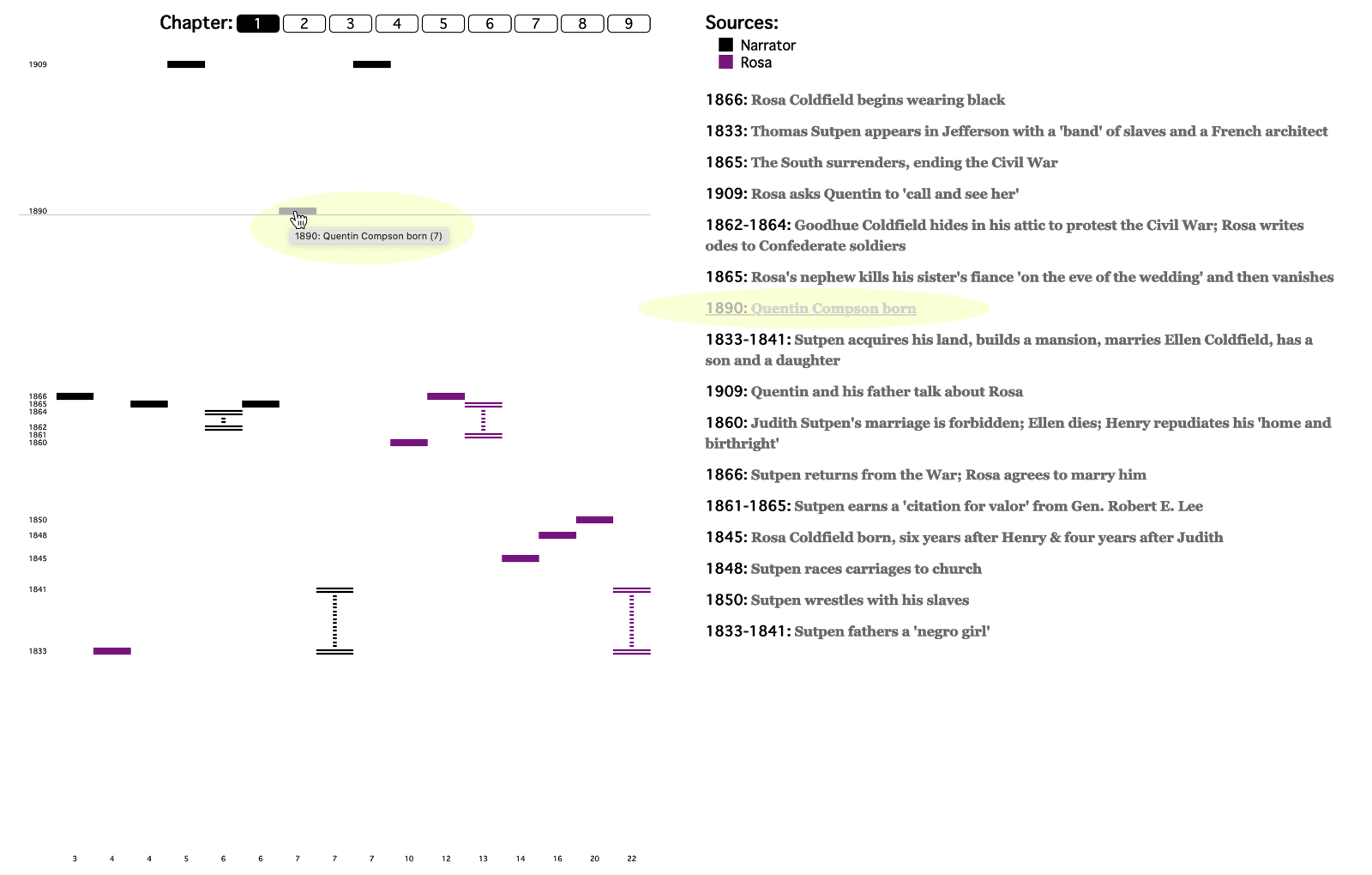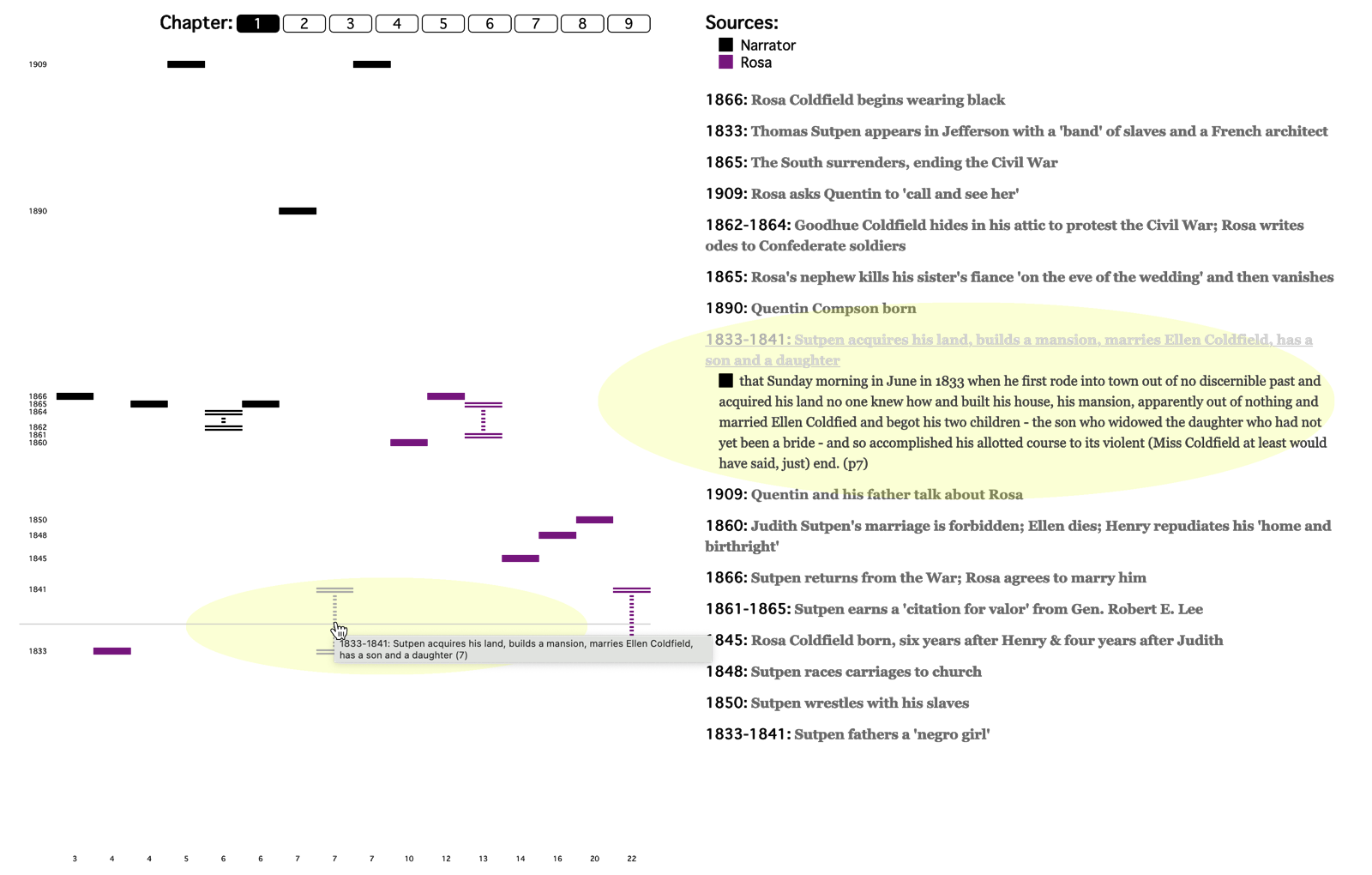Chronology About
|
About Absalom, Absalom!: Chapter-by-Chapter ChronologyThe first section below explains why, given the fact that most editions of Absalom include a “Chronology” of significant events written by Faulkner himself, we designed this digital chronology for first-time readers. The second section, A Pair of Warnings, explains how both “significant” and “events” are conditional terms, not definitive claims. The third section describes how to use use our chronology. Rationale: The idea for this presentation grew from my experience teaching Absalom to college students who were motivated and experienced with other Faulkner texts but who, because of the novel’s extremely difficult prose style, found themselves reaching the end of a chapter or even the bottom of a page with no clear idea what is happening in the story. The novel’s very first reader was Faulkner’s editor, Hal Smith. As he worked through the manuscript Smith grew increasingly alarmed about this problem. Probably at his request, Faulkner created a map of Yoknapatawpha, a “Genealogy” of the major characters, and a “Chronology” listing 33 important events in the story that lies behind the novel’s narrative. Random House printed these explanatory materials at the end of the book, and they are still included in the Vintage International edition that my students were reading. I was reluctant, however, to point them to Faulkner’s Chronology for help keeping track of the plot of the story. Absalom unfolds with deliberate ambiguity and uncertainty through the accounts of five different story-tellers – a third-person narrator, Miss Rosa, Mr. Compson, Quentin and Shreve – who use a dozen more sources along with their own imaginations and personal prejudices to try to reconstruct the past that haunts the South. Their versions complement, complicate and contradict each other as the novel works toward what may be a dramatic epiphany about the past and its legacy at the end of the penultimate chapter. Consulting Faulkner’s Chronology before you’ve read the whole narrative, however, is like reading an inept detective fiction that identifies who done it less than halfway through the book: five of the Chronology’s first six items give away crucial plot points that the actual narrative withholds until it approaches the end. To give students an alternative way to get a grasp on the main events of the story, one that stays closer to the actual experience of reading the novel as that story is told and retold, Will Rourk and I in 2011 created a Flash-based, online prototype of this chapter-by-chapter chronology. Read each chapter first, I told my students, and then use the electronic chronology to clarify the main events disclosed in that chapter. That Flash-based version no longer works. This version of the chronology has been rebuilt by Doug Ross. And while it was designed with first-time readers in mind, I hope it might help even veteran ones discover new ways to engage the text. It certainly did that for me. Until I saw the graphs of the nine chapters, for instance, I hadn’t realized just how many significant events I had selected cluster around 1860-1866 – the era of the Civil War. While Faulkner’s story takes place across more than a century, 53 of the 126 events in this chronology (42%) occur within that six-year period. Sure, among its main cast members are a Confederate general, a colonel, a major, a lieutenant and a private – but the Union army is never seen, and there are almost no Northern characters at all. The story does intersect briefly, for example, with the Battle of Gettysburg. But it is by no means a “war story.” That epiphany at the end of Chapter 8 I mentioned is by far the book’s longest scene with a military setting, but the conflict it dramatizes, while unmistakably Southern, is not at all military, and its major characters are all wearing Confederate uniforms. Graphing the narrative helped me realize how powerfully, and how tragically, Absalom, Absalom! redefines the familiar phrase “brother against brother.” A Pair of Warnings. First caveat: this chronology consists of 126 events, between 8 and 16 per chapter. It includes almost all of the 33 in Faulkner’s Chronology, but adds many others that were chosen by me for their narrative and thematic significance. Another editor could have selected more, or fewer, or different events. I don’t claim my list is definitive, but rather – like each story-teller’s version of the story – an interpretive act. My self-imposed limit of 16 events per chapter is meant to keep each batch small enough to be manageable and useful to a first-time reader. A second caveat: with this novel the word event should always be in quotation marks. There is no “event” on these lists, or Faulkner’s for that matter, that we can say “really happened.” One of novel’s central themes is how the past can only be reconstructed, not lived firsthand, and so even the reliability of the book’s third-person narrator, who is looking back on the story a quarter century after its last event takes place, may be unreliable. It is up to each reader to decide which story-tellers, sources or events give us the best access to the past. For this reason, our chronology color-codes the specific narrator or narrative source for each event. Black icons are used, for example, to identify the third-person narrator’s contributions. Between 2 and 10 sources are responsible for the reconstructions in each chapter; they are identified at the top of each chapter’s page. Here are all 16 sources and their respective color codes:  (NOTE: hyphens and stripes are used when it seems a source is relying on and perhaps revising another source, such as when Mr. Compson in 1909 relays what his father, General Compson, told him years earlier. The composites “Quentin-Shreve” and “Shreve-Quentin” are our way of distinguishing which is actually speaking in those passages where the narrative says the two are in perfect agreement; the actual speaker is listed first.) Using the Chronology: Your first step in using the program is choosing the chapter you want to review by clicking on any of the 9 boxes at the top left of the page. Your choice will be highlighted in red, as Chapter 1 is here. All the following illustrations are from that chapter. Below you can see how that chapter’s 16 events are displayed on both the lefthand graph and the righthand list.  The list of Chapter 1 events on the righthand is sorted in the order of their appearance in the text, from page 3 to page 22 in the 2011 Vintage paperback. On the graph, the same events are located in both narrative and chronological order. The horizontal x-axis plots events from left to right as they occur in the text; the numbers below the axis are page numbers. The vertical y-axis indicates when an event occurs in time, from 1800 at the bottom up to 1910 at the top; the numbers to the left of the y-axis are dates. (NOTE: when you use the program on your computer or laptop, you may have to scroll down to see the earliest events on the graph or the events that occur later in a chapter on the righthand list.)
 The icon in the example highlighted here is black, identifying the novel’s narrator as its source. It appears at the left of the x-axis and near the top of the y-axis – that is, early in the narrative but late in the story. The example also highlights what happens when you move your cursor over an icon: a brief description of the event itself as well as its date and page number pop up on the graph. The graph’s visualization of this information may prompt us to reflect on one of the central facts of this novel: that Quentin is present from the beginning of the narrative to its final page, yet is born only after almost all the story is in the past that Faulkner finds many ways to remind us “is never dead.” You can also see in this example how the graph and the list are interlinked: with your cursor over the icon, the position of the event on the list is indicated. Highlighted on the illustration below is the icon we use to plot multi-year events on the graph:
 I wrote the descriptions of the events on graphs and list, but this illustration also shows what happens when you click on an graph icon or a list item: clicking expands the list entry to include the passage from Absalom where the event is first mentioned. This feature allows you to work back from our re-presentation of the novel to Faulkner’s actual text. That, of course, is what we hope this resource ultimately gives you: a means, not an end – a way to return to Absalom, Absalom! perhaps a bit readier to appreciate and understand it. – Stephen Railton For more on Faulkner, Hal Smith, and the published “Chronology,” see “Absalom, Absalom! Manuscripts Etc. and Absalom, Absalom! The Chronologies - but remember that Faulkner’s chronology includes a lot of spoilers! For more on the novel’s various sources, see The Narrative Sources of Absalom, Absalom! Citing this resource:
|
- Log in to post comments

Comments
jburgers@gc.cuny.edu
Sat, 2024-11-23 10:03
Permalink
* Added TOC
* Added TOC
* Some small edits to the text
* Split into three sections